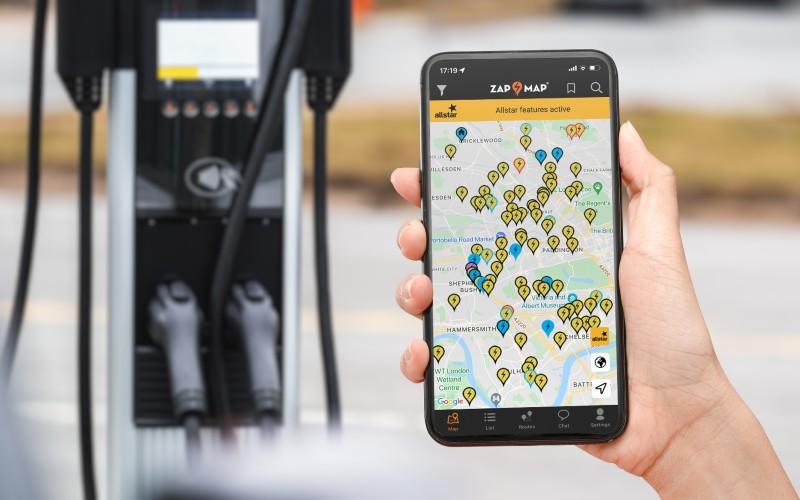When I bought an electric car a few years ago – with all the questions that such a leap into the unknown brings – one app stood out above all others.
Zap-Map was the most accessible and reliable way of researching chargepoints. If, for example, I needed to take the Leaf to watch football, where would I need to stop to avoid running out of battery? Could I use that operator’s service? And how long would it take to charge?
The EV has since gone – we became a one-car family again during COVID – but Zap-Map is charging ahead after raising £9 million of Series A funding from Good Energy and Fleetcor UK Acquisition last year.
The origins of the Bristol-based company, star of our TransportTech 50 ranking late last year, go back to 2006 – as COO Melanie Shufflebotham explains to BusinessCloud.
“My co-founder Dr Ben Lane has a PhD in fuel cells technology and he created Next Green Car, a website which gave an environmental lifecycle rating – from 0-100 – for cars across different technologies,” she tells us.
“It looked not just at the CO2, but also the emissions coming out of the tailpipe, in the production of the car and the fuel production. He applied this theoretical analysis to an actual database of cars so consumers could compare and contrast, and make decisions on which cars were the most environmentally friendly.
“It was really helpful for companies with targets for decarbonising their fleet… it was ahead of its time and helped hundreds of thousands of people.”
Zapmap – search for EV charging points, plan journeys and pay for charging with Zapmap.
Spinning out
With the launch of affordable EVs in the Nissan Leaf, Renault Zoe and BMW i3, the company created a map to help drivers identify chargepoints on their travels.
“Over time this page became the biggest on the website. We could see we were on to something so we set it free on its own and created a brand for it,” says Shufflebotham (pictured below), a former strategic partnership manager at T-Mobile with experience within software and hardware technology businesses.
“Because we come from digital publishing, we knew the value of creating a lot of content around the core product. We answered the questions of drivers even before they bought an EV: where can I find charging? How long does it take to charge? Where are the various public networks? How much do they cost? We created guides around the core product.”
The Next Green Car website closed in January 2023, long since superseded by the Zap-Map website and app.
UK adoption
With an accelerated 2030 target of 100% all-electric vehicles in the manufacturing industry, the government has rolled out several schemes to encourage adoption and build infrastructure on both a national and local scale.
It is also mandating chargepoint reliability, contactless payments and open pricing. “Broadly speaking, it’s working well,” says Shufflebotham. “But demand is not the issue; it’s all about supply.”
Last December, 33% of all cars sold were pure electric – 42,000 new EVs on the road in one month – while charging infrastructure had a record year in 2022, growing by 30%.
There was also a 78% increase in ultra rapid chargers (100kW+), with 100 new charging hubs housing more than four rapid/ultra rapid chargers (up 56%).
“These high-speed, ultra-rapid chargers which we need for the longer journeys are key. Of equal importance is that increasingly they are being installed in hubs – the petrol station model – which gives reliability and redundancy,” reflects the COO.
“However, I would like to see more affordable electric cars coming out.”
TransportTech 50 – UK’s most innovative transport technology creators for 2022
Added value
Free to use at its most basic level, the business model for Zap-Map revolves around layering on services for a loyal customer base and EV newcomers.
Users can now pay for charging across networks – a real pain-point for me in the Leaf days – and create VAT receipts via Zap-Pay; access enhanced features and filters; and incorporate Zap-Map into their in-car dashboard to see live chargepoint data, access intelligent route and charging plans, and link to navigation apps.
This helps to alleviate the phenomenon of range anxiety, which often kicks in at motorway speeds when reported battery levels drop off a cliff and you can’t safely refer to your phone.
Expansion to Europe is in the pipeline, followed by North America. “The US is behind Europe in terms of EV adoption,” says Shufflebotham.
She adds: “We’re now looking to build our insights business. We’ve got amazing extensive data, not just from chargepoints, but from EVs and also our community. We play a really important role in providing information to help the broader EV industry to develop products.”
Insights

Jade Edwards (above) joined as head of insights in April 2022. “Mel was already doing an incredible job with our unique data set to create distinct services, stats and analysis for the EV industry – it’s my remit to come in and take it to the next stage,” says Edwards.
“Businesses come to us and need to understand where the rapid chargers are across the UK; where new ones are being added; and which network they belong to. Are they in supermarket car parks? Or are they on fuel forecourts?
“We then clean that data and append lots of other information to it for a rich database. The Department for Transport even uses our data as the official statistic for the number of chargepoints in the UK.”
Insight into how those chargepoints are used is also valuable, according to Edwards. “Data scientists pool the charging data so we can provide reports to help the industry understand the pace and nature of adoption.”
Zap-Map’s user base includes 40,000 EV drivers on a survey panel. “We get 4,000+ responses. Our users are so engaged that they love talking about EVs and charging so they will answer our questions.
“We’ve created a quarterly price index for EV charging: with the usage data that we have – we record more than 500,000 sessions every month – and pricing from the networks, we can work out weighted pricing. What are people actually paying out on the public network?
“The overall increase in wholesale electricity is what has driven a 14% increase in the Rapid Price Index over the last three months of 2022. But as the number of new charging points in the ground continues to expand, the choices EV drivers make about where to charge will have an impact too.”

